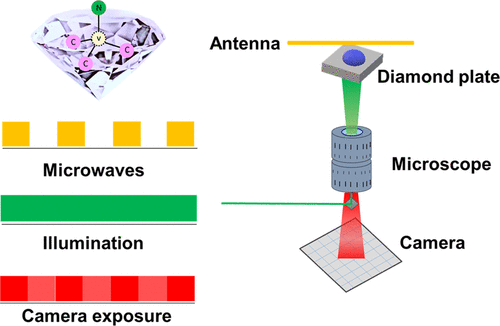Our official English website, www.x-mol.net, welcomes your feedback! (Note: you will need to create a separate account there.)
Dynamic Quantum Sensing of Paramagnetic Species Using Nitrogen-Vacancy Centers in Diamond.
ACS Sensors ( IF 8.9 ) Pub Date : 2020-01-08 , DOI: 10.1021/acssensors.9b01903 Valentin Radu 1 , Joshua Colm Price 1 , Simon James Levett 1 , Kaarjel Kauslya Narayanasamy 2 , Thomas David Bateman-Price 1 , Philippe Barrie Wilson 3 , Melissa Louise Mather 1
ACS Sensors ( IF 8.9 ) Pub Date : 2020-01-08 , DOI: 10.1021/acssensors.9b01903 Valentin Radu 1 , Joshua Colm Price 1 , Simon James Levett 1 , Kaarjel Kauslya Narayanasamy 2 , Thomas David Bateman-Price 1 , Philippe Barrie Wilson 3 , Melissa Louise Mather 1
Affiliation

|
Naturally occurring paramagnetic species (PS), such as free radicals and paramagnetic metalloproteins, play an essential role in a multitude of critical physiological processes including metabolism, cell signaling, and immune response. These highly dynamic species can also act as intrinsic biomarkers for a variety of disease states, while synthetic paramagnetic probes targeted to specific sites on biomolecules enable the study of functional information such as tissue oxygenation and redox status in living systems. The work presented herein describes a new sensing method that exploits the spin-dependent emission of photoluminescence (PL) from an ensemble of nitrogen-vacancy centers in diamond for rapid, nondestructive detection of PS in living systems. Uniquely this approach involves simple measurement protocols that assess PL contrast with and without the application of microwaves. The method is demonstrated to detect concentrations of paramagnetic salts in solution and the widely used magnetic resonance imaging contrast agent gadobutrol with a limit of detection of less than 10 attomol over a 100 μm × 100 μm field of view. Real-time monitoring of changes in the concentration of paramagnetic salts is demonstrated with image exposure times of 20 ms. Further, dynamic tracking of chemical reactions is demonstrated via the conversion of low-spin cyanide-coordinated Fe3+ to hexaaqua Fe3+ under acidic conditions. Finally, the capability to map paramagnetic species in model cells with subcellular resolution is demonstrated using lipid membranes containing gadolinium-labeled phospholipids under ambient conditions in the order of minutes. Overall, this work introduces a new sensing approach for the realization of fast, sensitive imaging of PS in a widefield format that is readily deployable in biomedical settings. Ultimately, this new approach to nitrogen vacancy-based quantum sensing paves the way toward minimally invasive real-time mapping and observation of free radicals in in vitro cellular environments.
中文翻译:

利用金刚石中的氮空位中心对顺磁性物质进行动态量子感测。
天然的顺磁性物质(PS),例如自由基和顺磁性金属蛋白,在包括代谢,细胞信号传导和免疫反应在内的许多关键生理过程中起着至关重要的作用。这些高度动态的物种还可以充当多种疾病状态的内在生物标记,而针对生物分子特定位点的合成顺磁探针可以研究功能信息,例如生命系统中的组织氧合和氧化还原状态。本文介绍的工作描述了一种新的传感方法,该方法利用了自旋相关的钻石中氮空位中心的集合体发出的光致发光(PL),以快速,无损地检测生物系统中的PS。独特的是,此方法涉及简单的测量协议,该协议可在有无微波的情况下评估PL的对比度。已证明该方法可检测溶液中顺磁性盐的浓度以及广泛使用的磁共振成像造影剂加多布特罗,在100μm×100μm视场中的检出限小于10 attomol。通过20 ms的图像曝光时间可以实时监控顺磁性盐浓度的变化。此外,通过在酸性条件下将低自旋氰化物配位的Fe3 +转化为六水合Fe3 +,可以动态跟踪化学反应。最后,使用含有g标记的磷脂的脂膜在几分钟内在环境条件下证明了能够以亚细胞分辨率在模型细胞中绘制顺磁性物质的图谱。总体而言,这项工作引入了一种新的传感方法,可实现在宽广范围内对PS进行快速,灵敏的成像,并且可以在生物医学环境中轻松部署。最终,这种基于氮空位的量子传感新方法为微创实时制图和体外细胞环境中自由基的观察铺平了道路。
更新日期:2020-01-09
中文翻译:

利用金刚石中的氮空位中心对顺磁性物质进行动态量子感测。
天然的顺磁性物质(PS),例如自由基和顺磁性金属蛋白,在包括代谢,细胞信号传导和免疫反应在内的许多关键生理过程中起着至关重要的作用。这些高度动态的物种还可以充当多种疾病状态的内在生物标记,而针对生物分子特定位点的合成顺磁探针可以研究功能信息,例如生命系统中的组织氧合和氧化还原状态。本文介绍的工作描述了一种新的传感方法,该方法利用了自旋相关的钻石中氮空位中心的集合体发出的光致发光(PL),以快速,无损地检测生物系统中的PS。独特的是,此方法涉及简单的测量协议,该协议可在有无微波的情况下评估PL的对比度。已证明该方法可检测溶液中顺磁性盐的浓度以及广泛使用的磁共振成像造影剂加多布特罗,在100μm×100μm视场中的检出限小于10 attomol。通过20 ms的图像曝光时间可以实时监控顺磁性盐浓度的变化。此外,通过在酸性条件下将低自旋氰化物配位的Fe3 +转化为六水合Fe3 +,可以动态跟踪化学反应。最后,使用含有g标记的磷脂的脂膜在几分钟内在环境条件下证明了能够以亚细胞分辨率在模型细胞中绘制顺磁性物质的图谱。总体而言,这项工作引入了一种新的传感方法,可实现在宽广范围内对PS进行快速,灵敏的成像,并且可以在生物医学环境中轻松部署。最终,这种基于氮空位的量子传感新方法为微创实时制图和体外细胞环境中自由基的观察铺平了道路。



























 京公网安备 11010802027423号
京公网安备 11010802027423号